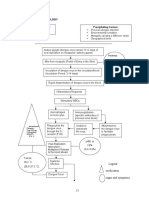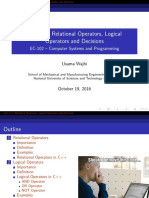Unit 4
Unit 4
Uploaded by
Raviteja UdumudiCopyright:
Available Formats
Unit 4
Unit 4
Uploaded by
Raviteja UdumudiCopyright
Available Formats
Share this document
Did you find this document useful?
Is this content inappropriate?
Copyright:
Available Formats
Unit 4
Unit 4
Uploaded by
Raviteja UdumudiCopyright:
Available Formats
Unit 4
IMAGE RESTORATION
IMAGE RESTORATION
4.1 INTRODUCTION:
Image restoration in an area deals with improving the appearance of an image. However, unlike enhancement, which is subjective, image restoration is objective, in the sense that restoration techniques tend to based on mathematical or probabilistic models of image degradation. Restoration attempts to reconstruct or recover an image that has been degraded by using a priori knowledge of the degradation phenomenon. Thus restoration techniques are oriented towards modeling the degradation and applying the inverse process in order to recover the original image.
4.2 IMAGE DEGRADATION MODEL:
A model of the Image Degradation / Restoration process
The fig. shows, the degradation process is modeled as a degradation function that, together with an addition noise term, operates on an input image f(x, y) to produce a degraded image g(x, y). given g(x, y) some knowledge about degradation function H, and some knowledge about the additive noise term (x, y) the objective of restoration is to obtain an estimation of the original image. The requirement is the estimate be as close as possible to the original input image and, in general, the more we know about H and , the closer will be to f(x, y). the approach used throughout most of this is based on various types of images restoration filters. If H is a linear, position invariant process, then the degradation image is given in the spatial domain by . Where is the spatial representation of the degradation function and as symbol * indicates spatial convolution. Convolution in the spatial domain is equal to multiplication in the frequency domain, the equivalent frequency domain representation. .. (4.1) Where the terms in capital letters are Fourier transforms of corresponding terms, H is identity operator. 4.2.1 INVERSE FILTERING: The simplest approach to restoration is direct inverse filtering, where an estimate, of the transform of the original image simply by dividing the transform of the degraded image G(u, v), by the degradation function. = (4.2) The divisions are between individual elements of the function where G(u, v) = H(u, v) * F(u, v) + N(u, v) substitute G(u, v) in eq.(1) i.e.,
Unit 4
IMAGE RESTORATION
= F(u, v) +
.. (4.3)
The expression tells us that even if we know the degradation function we cannot recover the underground image [ inverse fourier transform of F(u, v)] exactly because N(u, v) is a random function whose fourier transform is not known. If the degradation has zero or very small values then the ratio N(u, v) / H(u, v) could easily dominant the estimate . One approach to get around the zero or small value problem is to limit the filter frequency to the value near the origin. We know that H(0, 0) is equal to the average value of h(x, y) and that is usually highest value of H(u, v) in the frequency domain. Thus by limiting the analysis to frequencies near the origin, we reduce the probability of encountering zero values. Note: Consider the Gaussian function at high frequency H(u, v) is low. Hence 1/H(u, v) will be large i.e., the noise is more in order to over come this problem we are not considering the high frequency components we are setting the range in which we can have effective picture.
frequency 4.2.2 MINIMUM MEAN SQUARE ERROR (WIENER) FILTERING: Inverse filtering approach makes no explicit provision for handling noise. The method is founded on considering images and noise as random process and the objective is to find an estimate of the uncorrupted image f such that the mean square error between them is minimized. This error measures is given by (4.4) Where E{.} is the expected value of argument. It is assumed that the noise and the image or uncorrelated that one or other has zero mean; and that the grey levels in the estimate are a linear function of the levels in the error function in eq.1 is gain in the frequency domain by the expression [ =[
| |
] ]
| | | |
=[
. (4.5)
When we used the fact that the product of a complete quantity with its conjugate is equal to the magnitude of complex quantity squared. This result is known as Wiener filter. The terms inside the brackets are also called as minimum mean square error filter or the least square error filter. Wiener filter does not have the same problem as the inverse filter with zeros in degradation function unless both and (u,v) are zero for the same values (s) of u and v. =degradation function =complex conjugate H(u,v)
2
Unit 4
IMAGE RESTORATION
| =H*(u,v)H(u,v) =| =| | =power spectrum of the noise | =power spectrum of the un-degraded image
As before, is the transform of the degradation function and G(u,v) is the transform of the degraded image. The restored image in the spatial domain is given by the inverse fourier of the frequency-domain estimated . Note that if the noise is zero, then the noise power spectrum vanishes and the wiener filter reduces to the inverse filter. When dealing | is a constant, which simplifies things with spectrally white noise, the spectrum | considerably. However, the power spectrum of the un-degraded image seldom is known. An approach used frequently when these quantities are not known or cannot be estimated is to appropriate by the expression [ | | | | ]
Where K is a specified constant. 4.2.3 CONSTRAINED LEAST SQUARE FILTERING: Power spectra of the un-degraded image and noise must be known. A constant estimate of the ratio of power spectra is not always a suitable solution. Knowledge of only mean and variance of the noise is required. These parameters usually can be calculated from a given degraded image. Another difference is that the wiener filter is based on minimizing a statistical criterion and as such it is optimal in an average sense. The algorithm presented in this section has the notable future that yields an optimal result for each image to which it is applied. The choice of one algorithm over the other will almost always be determined (at least partially) by the perceived visual quality of the resulting images. By using the definition of convolution given we can express in vector matrix form, as follows; y=HF + (4.7) Suppose that g(x, y) is of size MxN. Then we can form the first N elements of the vector g by using the image elements in the first row of g(x, y), the next N elements from the second row, and so on. The resulting vector will have dimensions MN+1. These are also the dimensions of f and as these vectors are formed in the same manner. The matrix H then has dimensions MN x MN. Its elements are given by the elements of convoluting DOUBT. The restoration problem can be reduced to a simple matrix manipulation. Manipulating vectors and matrices of the large sizes is not a trivial. The problem is complicated further the fact H is highly sensitive to formulating the restoration problem in matrix form does facilitate elements of restoration techniques. One way to DOUBT to noise sensitive is to base optimality of restoration on a measure of smoothness, DOUBT second derivative of an image. The restoration must be constrained the parameters of the problems at hand. Thus to find the SOUBT of a criterion function C, defined as C= . (4.71) subject to the constraint. (4.72)
Where is the Euclidian vector norm and is the error of the un-degraded image. The laplacian operator . The frequency solution to this optimization problem is given by the expression [|
| | |
.. (4.73)
3
Unit 4
IMAGE RESTORATION
Where parameter that must be adjusted so that the constraint is satisfied P(u,v) is the fourier transform of the function. P(x, y) = [ ]
P(x, y) end other relevant DOUBT domain functions, must be properly with zeros prior to computing their transform in eq.4 reduces to inverse filtering if is zero. A procedure for computing by iteration is as follows. Define an residual vector as =g-H therefore from eq. and by implication is a function of , then also a function parameter. It can be increasing function of the gamma wish to adjust as shown that ( ) =
the constraint eq.2 is highly satisfied. Because Where a is accuracy factor ( ) is monotonic, finding the value of is not difficult one approach is to 1. Specify an initial value of . 2. Compute . 3. Stoop when is satisfied otherwise return to step 2 after increasing If or decreasing use a new value of in eq.3 to recompute the optimum estimate .
You might also like
- Adventures of The Greek HeroesDocument7 pagesAdventures of The Greek HeroesAlexaOrtiz22No ratings yet
- Lawyers League Vs Aquino G.R. No. 73748 - May 22, 1986Document1 pageLawyers League Vs Aquino G.R. No. 73748 - May 22, 1986code4sale100% (3)
- Unit Iii Practice QuestionDocument21 pagesUnit Iii Practice QuestionSukanti PalNo ratings yet
- Digital Image ProcessingDocument26 pagesDigital Image ProcessingDensingh RajaNo ratings yet
- 1.discuss The Frequency Domain Techniques of Image Enhancement in DetailDocument19 pages1.discuss The Frequency Domain Techniques of Image Enhancement in DetailsubbuNo ratings yet
- Digital Image Processing Question & Answers: X' C X + C y + C Xy + CDocument18 pagesDigital Image Processing Question & Answers: X' C X + C y + C Xy + ChemavathyrajasekaranNo ratings yet
- Unit Iii PDFDocument21 pagesUnit Iii PDFSridhar S NNo ratings yet
- Lect3 6Document15 pagesLect3 6Chandan KumarNo ratings yet
- 1.discuss The Frequency Domain Techniques of Image Enhancement in DetailDocument19 pages1.discuss The Frequency Domain Techniques of Image Enhancement in DetailsubbuNo ratings yet
- Digital Image Processing (Image Restoration)Document34 pagesDigital Image Processing (Image Restoration)MATHANKUMAR.S100% (4)
- Image RestorationDocument28 pagesImage RestorationsansureNo ratings yet
- Wiener FilterDocument3 pagesWiener FilterGaurab DeyNo ratings yet
- Lec 5Document13 pagesLec 5al.obaidi.m.k.iNo ratings yet
- Ip Unit-3Document12 pagesIp Unit-3Arjun singhNo ratings yet
- Image Enhancement TechniquesDocument50 pagesImage Enhancement Techniquesviktor_venkyNo ratings yet
- 2 Marks QA and Part B Answers - MIP - Unit 3Document53 pages2 Marks QA and Part B Answers - MIP - Unit 3suhagajaNo ratings yet
- 1.discuss The Frequency Domain Techniques of Image Enhancement in DetailDocument19 pages1.discuss The Frequency Domain Techniques of Image Enhancement in DetailSandeep KishoreNo ratings yet
- Image Restoration Based On Deconvolution by Richardson Lucy AlgorithmDocument5 pagesImage Restoration Based On Deconvolution by Richardson Lucy AlgorithmfarisNo ratings yet
- Digital Image Processing: Assignment No. 2Document18 pagesDigital Image Processing: Assignment No. 2Daljit SinghNo ratings yet
- DIP NotesDocument22 pagesDIP NotesSuman RoyNo ratings yet
- Lab 02Document14 pagesLab 02Mobaswir Al FarabiNo ratings yet
- ECE - DIP - Unit 4Document43 pagesECE - DIP - Unit 4Maheswaran UmaiyorupaganNo ratings yet
- What Is Digital Image? Intensity Gray LevelDocument19 pagesWhat Is Digital Image? Intensity Gray Leveljenish2No ratings yet
- Comparative Study of Color Image Restoration Algorithms For Remote Farming ApplicationDocument4 pagesComparative Study of Color Image Restoration Algorithms For Remote Farming ApplicationerpublicationNo ratings yet
- Digital Image Processing Question & Answers: X' C X + C y + C Xy + CDocument18 pagesDigital Image Processing Question & Answers: X' C X + C y + C Xy + CDr SamNo ratings yet
- Lab ManualDocument13 pagesLab ManualcrpriyankhaaNo ratings yet
- Lecture 2: Image Processing Review, Neighbors, Connected Components, and DistanceDocument7 pagesLecture 2: Image Processing Review, Neighbors, Connected Components, and DistanceWilliam MartinezNo ratings yet
- Bayesian-Based Iterative Method of Image Restoration : P (HK - W J) P (W J)Document5 pagesBayesian-Based Iterative Method of Image Restoration : P (HK - W J) P (W J)Capitan TorpedoNo ratings yet
- n-1 n-1 -j2πnk/N n=0: Explain the Properties of 2D discrete Fourier Transform 1. SeparabilityDocument7 pagesn-1 n-1 -j2πnk/N n=0: Explain the Properties of 2D discrete Fourier Transform 1. SeparabilityArun EceNo ratings yet
- DIP+Important+Questions+ +solutionsDocument20 pagesDIP+Important+Questions+ +solutionsAditya100% (1)
- Lec 6Document5 pagesLec 6al.obaidi.m.k.iNo ratings yet
- Weiner Filter and Sub-Block Decomposition Based ImDocument6 pagesWeiner Filter and Sub-Block Decomposition Based ImSharmin SathiNo ratings yet
- DipppDocument4 pagesDipppKhushiNo ratings yet
- Unit-2 Image ProcessingDocument9 pagesUnit-2 Image ProcessingAkash YadavNo ratings yet
- Dip R20 Unit-3 NotesDocument18 pagesDip R20 Unit-3 Notesdeekshithavakalapudi31No ratings yet
- Unit 4 Image ProcessingDocument19 pagesUnit 4 Image Processingsavitaannu07No ratings yet
- Chapter 4Document36 pagesChapter 4alazarmatiyosNo ratings yet
- DIP - Lecture-11 - 12 - 13 - RKJ - Image RestorationDocument107 pagesDIP - Lecture-11 - 12 - 13 - RKJ - Image RestorationRahul PalNo ratings yet
- Image Filtering: A Comprehensive StudyDocument46 pagesImage Filtering: A Comprehensive StudyMurali YanamandalaNo ratings yet
- Student Name Id: Dereje Addise Gpcosc/0008/13Document21 pagesStudent Name Id: Dereje Addise Gpcosc/0008/13Zobahaa HorunkuNo ratings yet
- IT AssignmentDocument14 pagesIT AssignmentChandan KumarNo ratings yet
- Image RestorationDocument18 pagesImage Restorationnvnaitik7999No ratings yet
- R16 4-1 Dip Unit 2Document41 pagesR16 4-1 Dip Unit 2rathaiah vasNo ratings yet
- EC8093 Unit 3Document79 pagesEC8093 Unit 3Santhosh PaNo ratings yet
- Image Transform: Learning ObjectivesDocument19 pagesImage Transform: Learning ObjectivesRaviteja UdumudiNo ratings yet
- Image ProcessingDocument17 pagesImage ProcessingManjeet MrinalNo ratings yet
- Unit Iii Image RestorationDocument4 pagesUnit Iii Image RestorationNivethithaa DhanrajNo ratings yet
- Fundamentals of Spatial Filtering: Outline of The LectureDocument6 pagesFundamentals of Spatial Filtering: Outline of The LectureSyedaNo ratings yet
- Applications of Fractals: Math Modeling Final ProjectDocument17 pagesApplications of Fractals: Math Modeling Final ProjectDamir BojadzijaNo ratings yet
- Report Lab1Document13 pagesReport Lab1Jaam JamNo ratings yet
- DIPDocument7 pagesDIPHimanshu SharmaNo ratings yet
- Unit 2Document41 pagesUnit 2HambaNo ratings yet
- 2D FFTDocument19 pages2D FFTAngel MarianoNo ratings yet
- Image RestorationDocument41 pagesImage Restorationcsbits0% (1)
- DIGITAL Image Processing 6Document12 pagesDIGITAL Image Processing 6Attallah MohammedNo ratings yet
- 1.1 OverviewDocument51 pages1.1 Overviewjenish devNo ratings yet
- DIP-5-Image RestorationDocument21 pagesDIP-5-Image RestorationSomanath BalwantNo ratings yet
- Image Processing: Gaurav GuptaDocument38 pagesImage Processing: Gaurav GuptaKoteswara Rao LNo ratings yet
- Intensity Transformations and Spatial FilteringDocument5 pagesIntensity Transformations and Spatial FilteringBulbula KumedaNo ratings yet
- Unit 3,4,5 2 Marks, Question Bank - MEDICAL IMAGE PROCESSINGDocument22 pagesUnit 3,4,5 2 Marks, Question Bank - MEDICAL IMAGE PROCESSINGdaitdesignerclubNo ratings yet
- Blind Image Restoration Based On Wiener Filtering and Defocus Point Spread Function EstimationDocument5 pagesBlind Image Restoration Based On Wiener Filtering and Defocus Point Spread Function EstimationSalmaanCadeXaajiNo ratings yet
- Unit 5Document16 pagesUnit 5Raviteja UdumudiNo ratings yet
- Color Image ProcessingDocument15 pagesColor Image ProcessingRaviteja UdumudiNo ratings yet
- Unit 6Document15 pagesUnit 6Raviteja UdumudiNo ratings yet
- Unit 1Document22 pagesUnit 1Raviteja UdumudiNo ratings yet
- Image Transform: Learning ObjectivesDocument19 pagesImage Transform: Learning ObjectivesRaviteja UdumudiNo ratings yet
- Digital Image FundamentalsDocument4 pagesDigital Image FundamentalsRaviteja UdumudiNo ratings yet
- Chapter Eighteen: Solutions For Section 18.1Document9 pagesChapter Eighteen: Solutions For Section 18.1rubensNo ratings yet
- Protocol For Validation of Test Method For Assay ofDocument16 pagesProtocol For Validation of Test Method For Assay ofAsaikkutti AnnamalaiNo ratings yet
- Rhythmic/Melodic Accompaniment For The Music of Cordillera: Quarter 1 Module 3Document6 pagesRhythmic/Melodic Accompaniment For The Music of Cordillera: Quarter 1 Module 3Marissa ValenciaNo ratings yet
- Revesion QuideDocument250 pagesRevesion QuideSama Diares100% (1)
- Goldman Is Gone - Official Court MinutesDocument40 pagesGoldman Is Gone - Official Court MinutesAnonymous TpffosXHHNo ratings yet
- Pathophysiology of Our Case Study Viral Myocarditis Secondary To Dengue FeverDocument2 pagesPathophysiology of Our Case Study Viral Myocarditis Secondary To Dengue FevercarmaxetaNo ratings yet
- Software Architecture Business CycleDocument11 pagesSoftware Architecture Business CycleMahesh MahiNo ratings yet
- Introduction To World Religion and Belief SystemDocument48 pagesIntroduction To World Religion and Belief SystemAbigail R. DiaNo ratings yet
- Pooja Singh - Del HC - Bail OrderDocument17 pagesPooja Singh - Del HC - Bail Orderlexvantage1No ratings yet
- Unit 1B: Non Native Speakers Spanish 1 PROJECT OVERVIEW: IndividuallyDocument3 pagesUnit 1B: Non Native Speakers Spanish 1 PROJECT OVERVIEW: Individuallyapi-26436085No ratings yet
- South Carolina Maternal Morbidity and Mortality Review CommitteeDocument4 pagesSouth Carolina Maternal Morbidity and Mortality Review CommitteeABC15 NewsNo ratings yet
- 2016 - G.R. No. 183486, (2016-02-24)Document23 pages2016 - G.R. No. 183486, (2016-02-24)ArahbellsNo ratings yet
- The Way of Love - Overflow From A Sufi HeartDocument69 pagesThe Way of Love - Overflow From A Sufi HeartTaoshobuddha100% (1)
- G.R. No. 227363, March 12, 2019 People of The Philippines, Plaintiff-Appellee, V. Salvador Tulagan, Accused-AppellantDocument31 pagesG.R. No. 227363, March 12, 2019 People of The Philippines, Plaintiff-Appellee, V. Salvador Tulagan, Accused-AppellantShannon GayleNo ratings yet
- EngMath111 Module Prelim PDFDocument23 pagesEngMath111 Module Prelim PDFRoselyn Montilla QuiocsonNo ratings yet
- Dissertation Behavioural Finance.Document29 pagesDissertation Behavioural Finance.ratnesh8500No ratings yet
- Manjra Charitable Trust's: Degree Board/ University Year of Passing PercentageDocument3 pagesManjra Charitable Trust's: Degree Board/ University Year of Passing PercentageGaurav BhatkarNo ratings yet
- E M Barth E C W Krabbe From Axiom To DiaDocument380 pagesE M Barth E C W Krabbe From Axiom To DiaAdam LakhalNo ratings yet
- Petitioner Vs Vs Respondents Platon Martinez Flores San Pedro & Leano and Padilla & Padilla Law O Ce Ismael M. GuroDocument6 pagesPetitioner Vs Vs Respondents Platon Martinez Flores San Pedro & Leano and Padilla & Padilla Law O Ce Ismael M. GuroSabNo ratings yet
- Emdt201102 DLDocument48 pagesEmdt201102 DLXavier Tolapuerta DenfrenteNo ratings yet
- How God Calls His Ministers by Garner Ted ArmstrongDocument8 pagesHow God Calls His Ministers by Garner Ted ArmstrongTim KitchenNo ratings yet
- Lab # 5: Relational Operators, Logical Operators and DecisionsDocument20 pagesLab # 5: Relational Operators, Logical Operators and DecisionsShujaAmjadNo ratings yet
- Tips To Score A' For Paper (Kiv)Document6 pagesTips To Score A' For Paper (Kiv)Aky UcufNo ratings yet
- Culture: - SocietyDocument51 pagesCulture: - SocietyJan Rovyn JavierNo ratings yet
- Guia Likes and Dislikes 7° - 8°Document6 pagesGuia Likes and Dislikes 7° - 8°snake6919100% (1)
- People v. RiveraDocument2 pagesPeople v. RiveraNiña Gutierrez AlcarazNo ratings yet
- Western Classical Art Traditions (Report in Arts)Document3 pagesWestern Classical Art Traditions (Report in Arts)JanineP.DelaCruz0% (1)
- The Biology of CancerDocument21 pagesThe Biology of CancerSarthak70% (47)






























































































